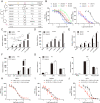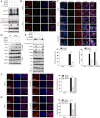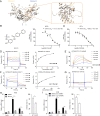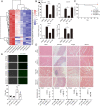STING inhibitors target the cyclic dinucleotide binding pocket
- PMID: 34099558
- PMCID: PMC8214703
- DOI: 10.1073/pnas.2105465118
STING inhibitors target the cyclic dinucleotide binding pocket
Abstract
Cytosolic DNA activates cGAS (cytosolic DNA sensor cyclic AMP-GMP synthase)-STING (stimulator of interferon genes) signaling, which triggers interferon and inflammatory responses that help defend against microbial infection and cancer. However, aberrant cytosolic self-DNA in Aicardi-Goutière's syndrome and constituently active gain-of-function mutations in STING in STING-associated vasculopathy with onset in infancy (SAVI) patients lead to excessive type I interferons and proinflammatory cytokines, which cause difficult-to-treat and sometimes fatal autoimmune disease. Here, in silico docking identified a potent STING antagonist SN-011 that binds with higher affinity to the cyclic dinucleotide (CDN)-binding pocket of STING than endogenous 2'3'-cGAMP. SN-011 locks STING in an open inactive conformation, which inhibits interferon and inflammatory cytokine induction activated by 2'3'-cGAMP, herpes simplex virus type 1 infection, Trex1 deficiency, overexpression of cGAS-STING, or SAVI STING mutants. In Trex1-/- mice, SN-011 was well tolerated, strongly inhibited hallmarks of inflammation and autoimmunity disease, and prevented death. Thus, a specific STING inhibitor that binds to the STING CDN-binding pocket is a promising lead compound for STING-driven disease.
Keywords: Aicardi–Goutières syndrome; SAVI; STING; antagonist; type I interferons.
Copyright © 2021 the Author(s). Published by PNAS.
Conflict of interest statement
The authors declare no competing interest.
Figures





Similar articles
-
ABCC1 transporter exports the immunostimulatory cyclic dinucleotide cGAMP.Immunity. 2022 Oct 11;55(10):1799-1812.e4. doi: 10.1016/j.immuni.2022.08.006. Epub 2022 Sep 6. Immunity. 2022. PMID: 36070769 Free PMC article.
-
A STING to inflammation and autoimmunity.J Leukoc Biol. 2019 Jul;106(1):171-185. doi: 10.1002/JLB.4MIR1018-397RR. Epub 2019 Apr 16. J Leukoc Biol. 2019. PMID: 30990921 Review.
-
Crystal structures of porcine STINGCBD-CDN complexes reveal the mechanism of ligand recognition and discrimination of STING proteins.J Biol Chem. 2019 Jul 26;294(30):11420-11432. doi: 10.1074/jbc.RA119.007367. Epub 2019 Jun 5. J Biol Chem. 2019. PMID: 31167783 Free PMC article.
-
The cGAS-STING signaling in cardiovascular and metabolic diseases: Future novel target option for pharmacotherapy.Acta Pharm Sin B. 2022 Jan;12(1):50-75. doi: 10.1016/j.apsb.2021.05.011. Epub 2021 May 20. Acta Pharm Sin B. 2022. PMID: 35127372 Free PMC article. Review.
-
Detection of Cyclic Dinucleotides by STING.Methods Mol Biol. 2017;1657:59-69. doi: 10.1007/978-1-4939-7240-1_6. Methods Mol Biol. 2017. PMID: 28889286
Cited by
-
The Relationship between Reactive Oxygen Species and the cGAS/STING Signaling Pathway in the Inflammaging Process.Int J Mol Sci. 2022 Dec 2;23(23):15182. doi: 10.3390/ijms232315182. Int J Mol Sci. 2022. PMID: 36499506 Free PMC article. Review.
-
Characteristics and genetic analysis of patients suspected with early-onset systemic lupus erythematosus.Pediatr Rheumatol Online J. 2022 Aug 13;20(1):68. doi: 10.1186/s12969-022-00722-6. Pediatr Rheumatol Online J. 2022. PMID: 35964089 Free PMC article.
-
STING is significantly increased in high-grade glioma with high risk of recurrence.Oncoimmunology. 2024 Mar 20;13(1):2327682. doi: 10.1080/2162402X.2024.2327682. eCollection 2024. Oncoimmunology. 2024. PMID: 38516268 Free PMC article.
-
Potential Therapeutic Value of the STING Inhibitors.Molecules. 2023 Mar 31;28(7):3127. doi: 10.3390/molecules28073127. Molecules. 2023. PMID: 37049889 Free PMC article. Review.
-
Targeting STING oligomerization with licochalcone D ameliorates STING-driven inflammatory diseases.Sci China Life Sci. 2024 Dec;67(12):2664-2677. doi: 10.1007/s11427-024-2703-6. Epub 2024 Aug 22. Sci China Life Sci. 2024. PMID: 39190126
References
Publication types
MeSH terms
Substances
LinkOut - more resources
Full Text Sources
Other Literature Sources
Molecular Biology Databases
Research Materials

